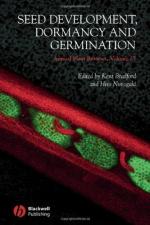|
This section contains 521 words (approx. 2 pages at 300 words per page) |

|
Seeds are usually shed from their parent plant in a mature dry state. The dry seed contains an embryo that is the next generation of the plant in miniature. Before the seed can grow, however, it must first emerge from the seed and establish itself as an independent, photosynthetic seedling. Germination, by definition, starts when the seed takes up water, a process known as imbibition, and is completed when the embryonic root, the radicle, penetrates the outer structures of the seed (usually the seed coat and, in some species, the surrounding storage tissues of the endosperm).
In the mature dry state, the seed is metabolically inactive (quiescent) and can withstand environmental extremes of temperature and drought. When water enters the seed during imbibition there is a leakage of solutes (ions, sugars, and amino acids) because cell membranes are temporarily unstable during hydration. Cellular metabolism recommences within minutes after...
|
This section contains 521 words (approx. 2 pages at 300 words per page) |

|


